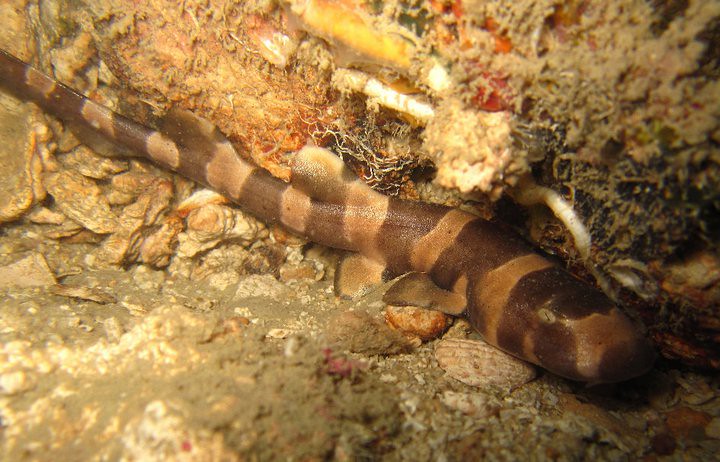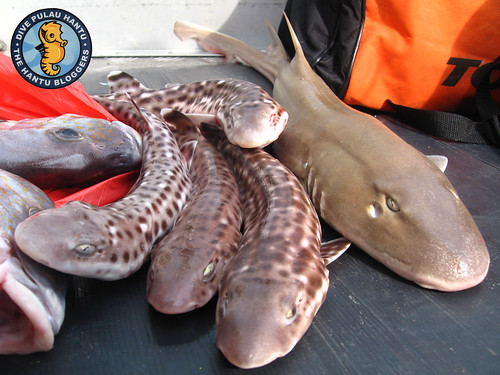The Sharks of Singapore
 July 19, 2018
July 19, 2018
If you were to mention ‘Singapore sharks’ to the average person on the street, the most likely response that you would get would be ‘…fin soup’. And then, depending on the environmental awareness of the respondent, either a heavy sigh or a licking of the lips. However, few Singaporeans know that Singapore has real live sharks, and I’m not talking about the sort that live in aquariums or work in the financial industry.
In this post, I highlight the beautiful local sharks of Singapore and share some of their unique traits. I also speak to a shark conservationist from Singapore and ask her what can be done to better protect these fine fishes. (Above: Hantu diver, Wyatt Ang, had his GoPro on at just the right time! Divers in the foreground missed the special encounter – wouldn’t it be great to have eyes on the back of your head!)
Sharks have gotten a bad (but inaccurate) reputation in popular media that depicts them as savage and ruthless hunters of humans. Jaws set the stage for this misunderstanding, but recent movies such as Meg have reinforced this perception.

This depiction, however, is far from the truth. Sharks live in Singapore’s waters and Hantu divers even swim with them from time to time. The most common sharks that are seen in Singapore’s waters come from the bamboo shark family (Hemiscylliidae) and a cute specimen was photographed on the Hantu reef during the 7th anniversary dive on Mar 2011.
The barbels (short pointy things) on the chin of these sharks earned them the nickname of ‘cat shark’ and, in my opinion, the adorable face and narrow pupils provide strong support for that nickname. Another specimen was sighted 3 months later by Cindy Tan with a better perspective of its whole body.
To further our knowledge of bamboo sharks, Dr Neil Hutchinson from James Cook University Singapore has been working on tagging bamboo sharks in Singapore to find out more about them (if you do spot one you can tell him about it here). As it stands, what scientists already know about them is fascinating. Like other sharks, bamboo sharks are capable of electroreception that allows them to detect and capture prey in the water. More interestingly, baby bamboo sharks have been found to detect electronic impulses from potential predators while they are still in their eggs. The baby sharks then temporarily stop their gill movements to reduce the chances of their egg being found and eaten by predators.
On top that, some bamboo sharks were trained by researchers to complete visual tests for food and they were found to be able to complete the same test after a 50 week break! This suggests that some bamboo sharks have memories that can last over a year.
But Singapore’s waters don’t just play host to bamboo sharks.During the course of his research, Dr Hutchinson has also come across coral catsharks and black tip reef sharks. Unfortunately, some of these sharks do end up as the catch of local fisherpeople.
This also reflects one of the greatest threats that sharks face today – people. WildAid estimates that up to 73 million sharks are killed each year for their fins. Local shark conservationist Kathy Xu notes that this is a problem because “sharks are apex predators, they are the lions of the oceans [and keep] the rest of the marine ecosystem in check.”
However, Kathy also notes that “it is also important for us to acknowledge … that ecosystems are complex and the food chains are not always so straightforward. There are many different species of sharks out there, each with different life histories and lifespans, [and they can exist on] different levels of the ecosystem”. This means that not all sharks play a role in keeping marine ecosystems in check (but that doesn’t make it OK to harvest them either!)

Kathy founded The Dorsal Effect in 2013 to advance shark protection in the region! The Dorsal Effect offers shark fisherpeople the opportunity to take up ecotourism instead.
When I ask Kathy what Singaporeans can do to better protect sharks, she notes that”it is important that [Singaporeans start] asking more questions about the traceability and source of the seafood they eat. Most Singaporeans may not be aware that shark meat can oftentimes be disguised in fish and chips or even the sweet and sour fish chunks of economical rice. So the one thing Singaporeans can do is to ask more questions about what they are eating and ensure that they always know if they are served shark meat or not as well make a conscious effort to put pressure on restaurants and sellers to find out exactly where and how the shark or seafood on their plate was obtained.”

Dried shark fin being sold in Singapore. Between 2005 and 2013, Singapore ranked third in the global shark fin trade. (Photo: Boon Being Ya / The Straits Times)
It is clear that more has to be done to protect sharks in Singapore and the waters beyond and this begins with consumer education and awareness. Declining shark fin at restaurants and events helps ensure that the fins stay in the water, attached to sharks! Stronger policy and regulation of the shark fin trade would also extend greater protection to the fine fishes. Finally, more research on the sharks in Singapore’s waters is also necessary so that we know what lives in the waters around us. After all, it is impossible to protect what we don’t know exists!





 Posted in
Posted in 



 content rss
content rss
COMMENTS